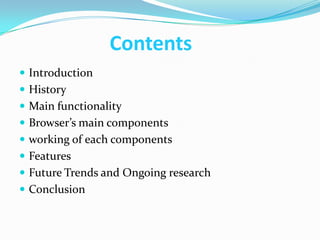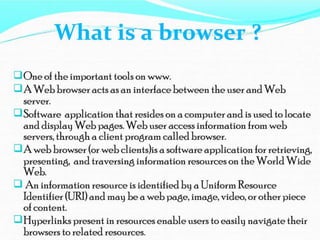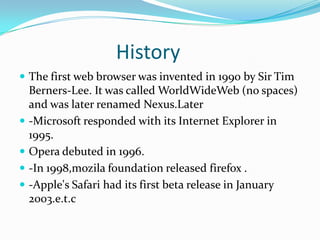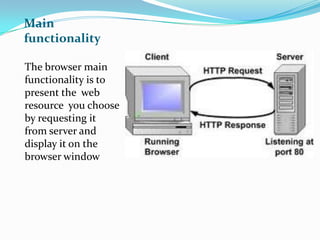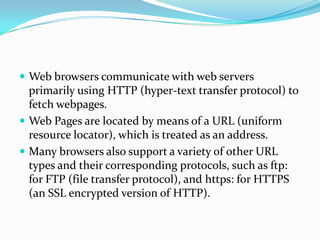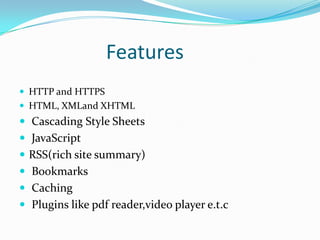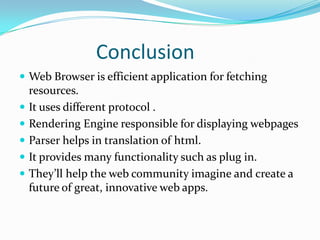Web browser
- 1. By Ashwini Kumar 10it21
- 2. Contents Introduction History Main functionality Browser’s main components working of each components Features Future Trends and Ongoing research Conclusion
- 4. History The first web browser was invented in 1990 by Sir Tim Berners-Lee. It was called WorldWideWeb (no spaces) and was later renamed Nexus.Later -Microsoft responded with its Internet Explorer in 1995. Opera debuted in 1996. -In 1998,mozila foundation released firefox . -Apple's Safari had its first beta release in January 2003.e.t.c
- 5. Main functionality The browser main functionality is to present the web resource you choose by requesting it from server and display it on the browser window
- 6. Web browsers communicate with web servers primarily using HTTP (hyper-text transfer protocol) to fetch webpages. Web Pages are located by means of a URL (uniform resource locator), which is treated as an address. Many browsers also support a variety of other URL types and their corresponding protocols, such as ftp: for FTP (file transfer protocol), and https: for HTTPS (an SSL encrypted version of HTTP).
- 7. Browser’s Main Component The user interface - this includes the address bar, back/forward button, bookmarking menu etc. The browser engine - the interface for querying and manipulating the rendering engine. The rendering engine - responsible for displaying the requested content. Networking - used for network calls, like HTTP requests. JavaScript interpreter-Used to parse and execute the JavaScript code. Data storage-The browser needs to save all sorts of data on the hard disk, for examples, cookies. The new HTML specification (HTML5) defines 'web database' which is a complete (although light) database in the browser. UI backend - used for drawing basic widgets like combo boxes and windows
- 8. Main component of a browser
- 10. Rendering Engine includes: 1. Rendering Process 2. Rendering Modes 3. Dynamic Pages 4. Resource Loading
- 11. Rendering Process Load the HTML Parse it Apply styles Build frames Layout the frames (flow) Paint the frames display
- 12. Rendering Engine The responsibility of the rendering engine is rendering, that is display of the requested contents on the browser screen. By default the rendering engine can display HTML and XML documents and images. It can display other types through a plug-in (a browser extension). An example is displaying PDF using a PDF viewer plug-in.
- 13. Features HTTP and HTTPS HTML, XMLand XHTML Cascading Style Sheets JavaScript RSS(rich site summary) Bookmarks Caching Plugins like pdf reader,video player e.t.c
- 14. Conclusion Web Browser is efficient application for fetching resources. It uses different protocol . Rendering Engine responsible for displaying webpages Parser helps in translation of html. It provides many functionality such as plug in. They’ll help the web community imagine and create a future of great, innovative web apps.
- 15. Thank You


